Search is changing. What began as a simple box where people typed keywords has transformed into an interactive experience where people ask questions and receive immediate answers.
This change affects how people find information online, creating new challenges and opportunities for businesses, marketers, and content creators.
TLDR
- Search is shifting from keyword-based queries to conversational interactions across multiple platforms.
- AI tools like ChatGPT, Perplexity, and Bing AI are redefining how users discover and interact with content.
- Google’s AI Overviews and zero-click searches are decreasing traditional organic traffic but increasing content visibility in new formats.
- Marketers must adapt content and SEO strategies to optimize for multi-modal, AI-powered search experiences.
- Agencies must evolve into strategic partners, integrating AI-readiness, structured data, and content that functions within fragmented search ecosystems.
Table of Contents
- The New Search Reality
- The Shift in Search Behavior
- From Keywords to Conversations
- New Search Engines and Tools
- AI Overviews Impact
- Search as a Destination
- Content Quality in an Age of Abundance
- Short-Term Impacts on SEO and SEA
- Long-Term Impacts on SEO and SEA
- Agency Evolution and Service Transformation
- Key Takeaways and Action Plan
The New Search Reality
As Ray Kurzweil observed, “The old links page paradigm of Internet search, which lasted for about 25 years, is rapidly being augmented with AI assistants” (Kurzweil, “The Singularity is Nearer“).
This shift affects:
- How businesses optimize their online presence
- What metrics matter for measuring success
- Which skills do digital marketers and SEO professionals need
- How agencies should structure their service offerings
We’re seeing search and conversation merge, creating a new way for people to find and interact with information.
The businesses and professionals who adapt to this change will find new opportunities in this evolving search environment.
This POV explores how conversational AI is changing search behavior, SEO/SEA strategies, and agency service models, examining both the immediate challenges and long-term opportunities of this transformation.
The Shift in Search Behavior
From Keywords to Conversations
People now expect to interact with search tools through natural questions rather than carefully crafted keywords.
They are moving away from search strings using simple short keywords towards conversational prompts that sound more like everyday human speech (How SEO Is Evolving in 2025: Context, Conversational AI)
This changes not just how we search, but the entire user journey of your customer.
This transition mirrors our growing comfort with AI interfaces that understand everyday language.
Instead of typing “best SEO tips,” people now ask, “What are the best SEO practices for my business in 2025?” expecting systems to grasp intent and context.
Eamonn’s analysis highlights how voice assistants and chatbots have normalized conversational interactions with technology, making this approach the new standard for search (LinkedIn, “The Key SEO Trend in 2025“).
We can even see that Google’s algorithm updates reward content increasingly to directly address user questions rather than targeting isolated keywords.
When someone can ask a complex question and get a direct answer without visiting a website, the traditional path from search to website visit is disrupted.
New Search Engines and Tools
Traditional search engines (Google, Bing, and others) now share the spotlight with “other search engines” like Pinterest, TikTok, YouTube, Amazon, Bol, and others, as well as AI search tools like ChatGPT, Bing AI, and Perplexity AI.
This represents more than just new technology—it shows a clear shift in what users want and expect when seeking information.
SEO changes from “Search Engine Optimization” to “Search Everywhere Optimization”.
Gartner research confirms this trend, reporting that by late 2028, 30% of Fortune 500 companies will offer services only through a single, AI-enabled channel that allows communication via text, images, and sound (Gartner, “Predicting the Future of AI Assistants,” 2024).
And if we look at the data right now, one in four Americans says they have used AI in place of traditional search engines (AI Search has a citation problem).

However, even if AI searches are on the rise, with the AI overviews in Google Search, the traffic of Google grew by 20% in 2024, and it still receives roughly 373 times more searches than ChatGPT:
- Google had more than 14 billion searches/day
- ChatGPT had (at the very most) 37.5M searches/day
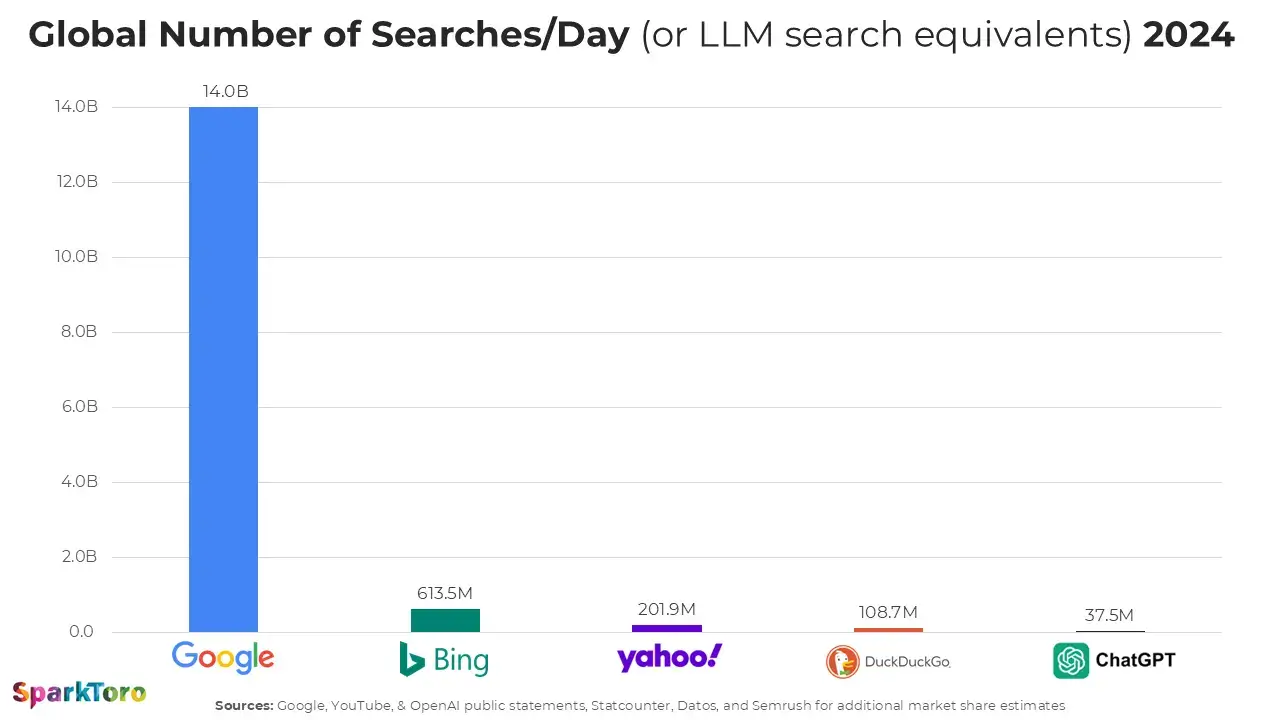
So, there is definitely a growing number of people beyond just first movers who are starting to use these tools. What is the impact on your business?
To understand the competitive landscape, it’s helpful to compare their scale.
While Google processes over 14 billion daily searches, ChatGPT handles about 37.5 million, and Perplexity around 14 million. Despite the hype, generative AI search still accounts for less than 2% of global search volume.
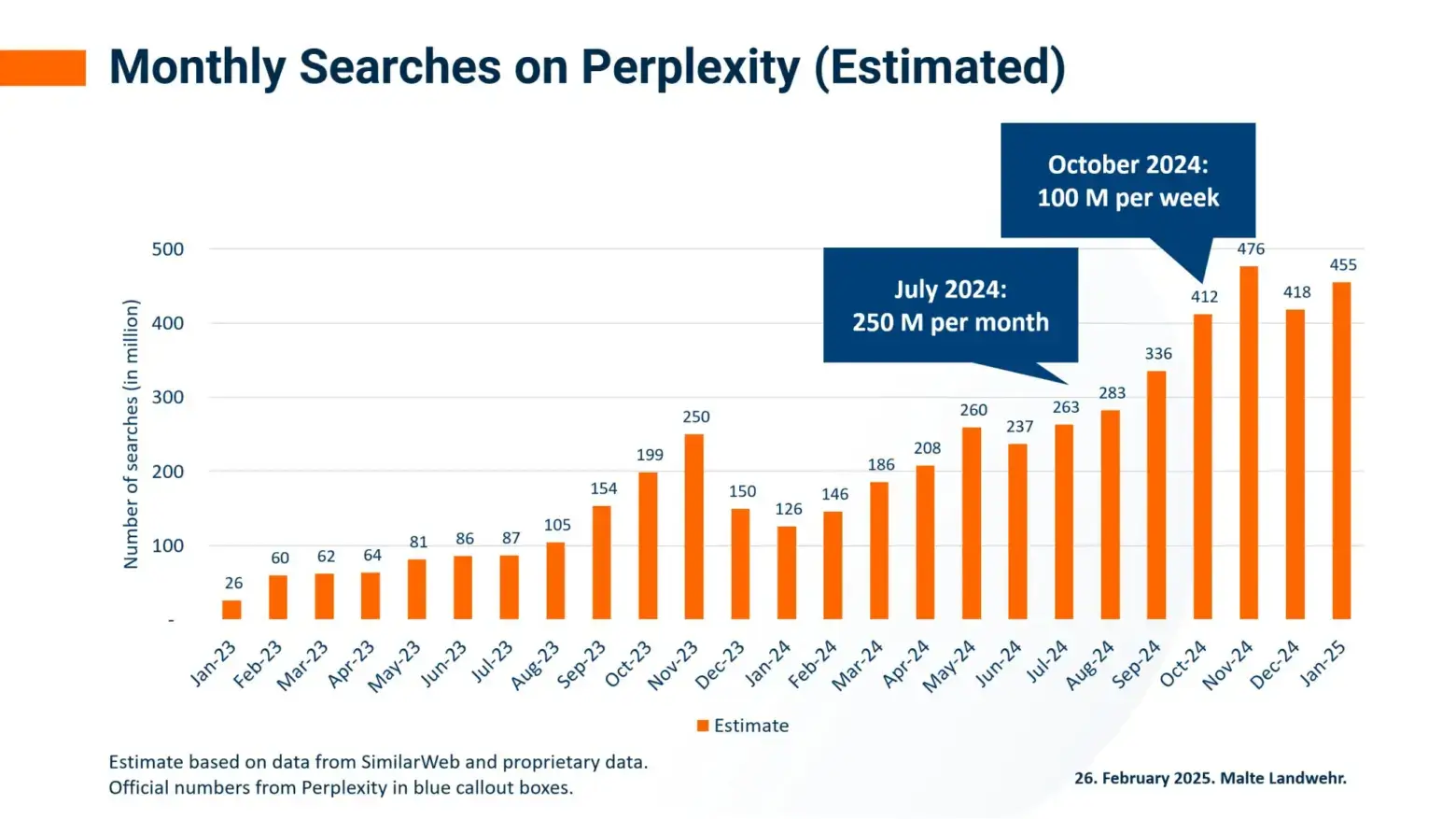
Perplexity’s funding ($9 billion valuation as of late 2024) and ChatGPT’s 500 M+ users show promise, but the user behavior shift is far from mainstream.
AI Overviews Impact
Well, it begins with a loss in traffic.
So, how much traffic loss are we talking about here?
Here’s how AI Overviews have decreased click-through rate (CTR) for traditional organic listings, according to the two studies:
- Ahrefs: A 34.5% drop in position 1 CTR when AI Overviews were present, based on an analysis of 300,000 keywords.
- Amsive: An average 15.49% CTR drop, with much larger losses in specific cases (e.g., -37.04% when combined with featured snippets), based on an analysis of 700,000 keywords.
Non-branded keywords. AI Overviews are much more likely to trigger on non-branded queries, and these terms showed the largest CTR drops:
- Amsive: -19.98% CTR decline on non-branded keywords.
- Ahrefs: Focused exclusively on informational intent (99.2% overlap with AI Overviews).
Lower rankings = bigger CTR hits. Google’s AI Overviews push organic results further down, minimizing visibility even for solidly ranking pages:
- There was a -27.04% CTR drop for keywords not in the Top 3 positions, according to Amsive:
AI Overviews benefit branded queries. Branded keywords are less likely to trigger AI Overviews (only 4.79%) – but when they do, they get a +18.68% CTR boost. This is possibly due to greater user intent and brand familiarity, according to Amsive.
However, the quality of the people who do tend to click through is higher:
AI Overviews, Google’s AI-generated summaries that sit above organic search results, are already eroding traffic for many publishers and creators. However, publishers are getting “higher-quality clicks,” according to Elizabeth Reid, Head of Google Search, in a new interview. (Google Search boss: AI Overviews boost click quality)
Some categories show more AI overviews than others:
| Industry | AI Overview Occurrence in SERPs |
| All Industries | 6.71% |
| Arts & Entertainment | 1.95% |
| Beauty & Fitness | 2.18% |
| Computer & Electronics | 8.75% |
| Finance | 4.38% |
| Food & Drink | 1.27% |
| Health | 23.02% |
| Hobbies & Leisure | 2.74% |
| Internet & Telecom | 11.72% |
| Real Estate | 0.41% |
| Science | 20.13% |
| Shopping | 1.98% |
| Spors | 2.24% |
| Travel | 9.99% |
Search as a Destination
Search is becoming a destination itself—a place where people find answers, make decisions, and take actions without clicking through to other sites.
Through the research of Semrush’s analysis of 80 million clickstream prompts, we know that 70% of prompts are for non-search-like functions: creating images, summarizing text, writing code, doing math homework that your kids really should have done themselves, etc.
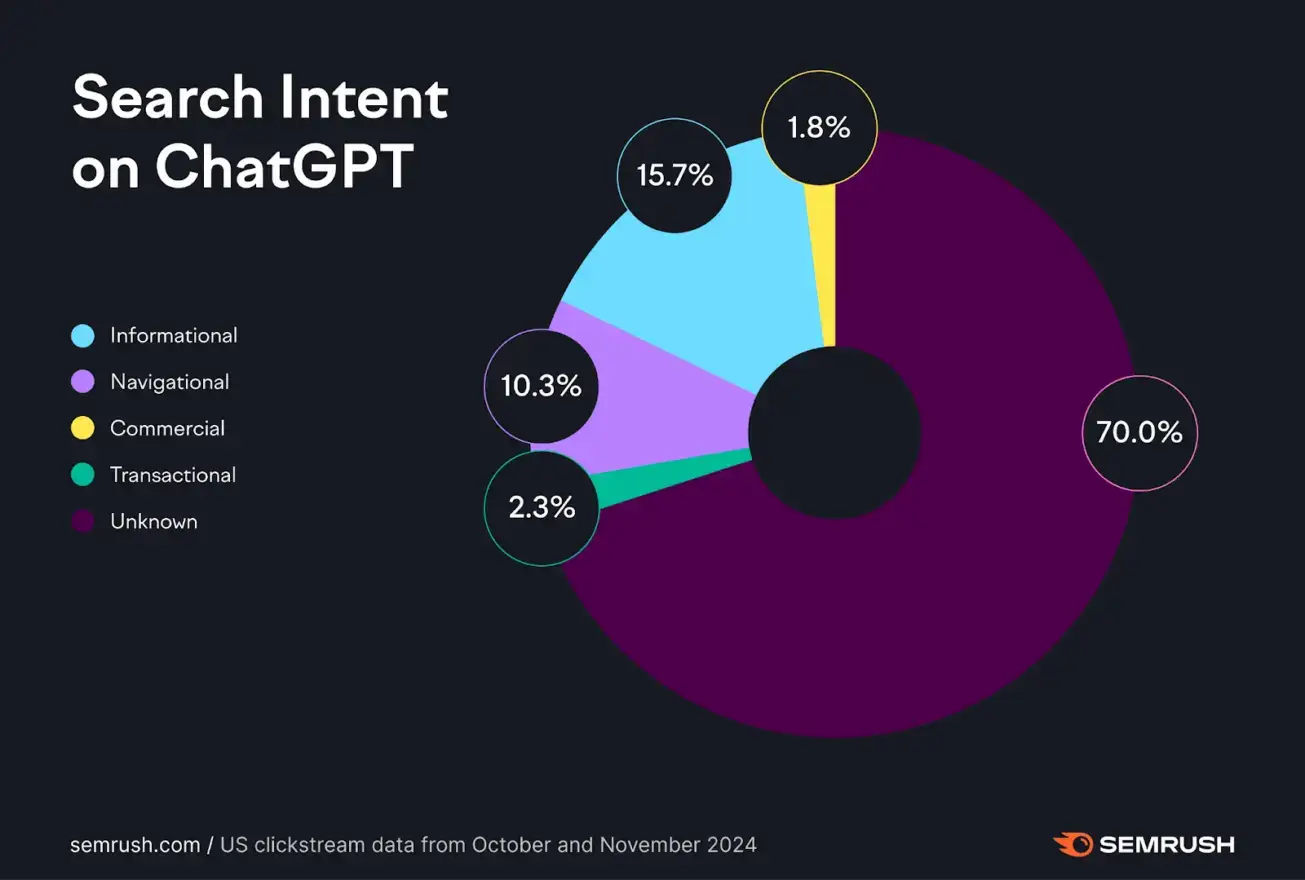
The ChatGPT prompts we care about are those that overlap with how people use search engines:
- to get information
- to navigate somewhere
- to compare options/assist in a buying or selection process
- or to specifically transact
That makes up 30% of ChatGPT’s use.
The 30% overlap with informational and decision-support queries is becoming meaningful.
The most dramatic change in search behavior is the rise of “zero-click searches,” where people get information directly from search results without visiting any websites, and this goes beyond the AI overviews we were talking about earlier.
The 2024 SparkToro and Datos analysis reveals that nearly 60% of searches now end without a click to external sites. Specifically, 58.5% of American searches and 59.7% of European searches don’t result in clicks to the open web.
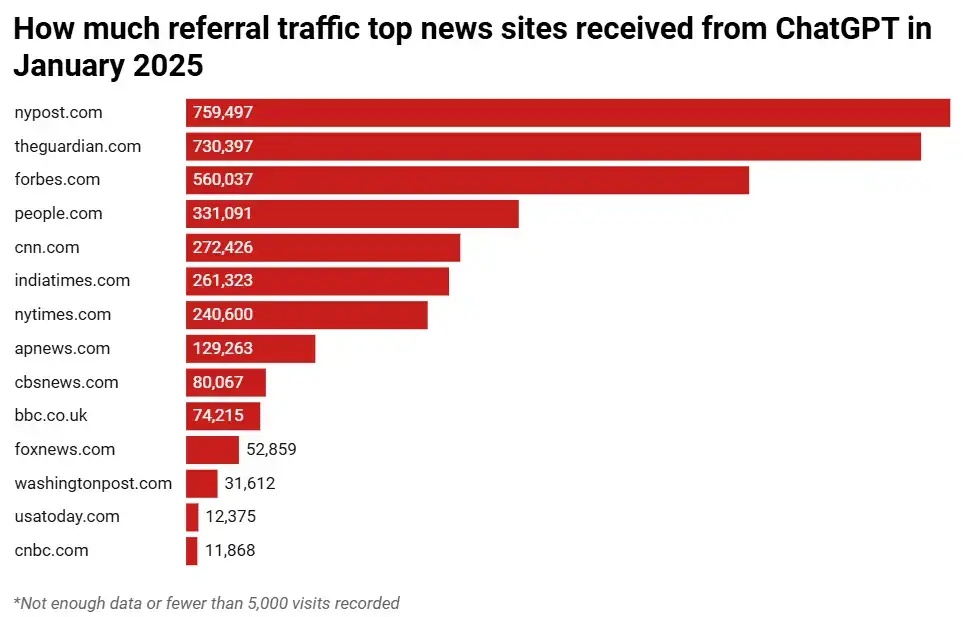
For every 1,000 Google searches, only 360-374 clicks actually reach websites outside Google’s ecosystem.
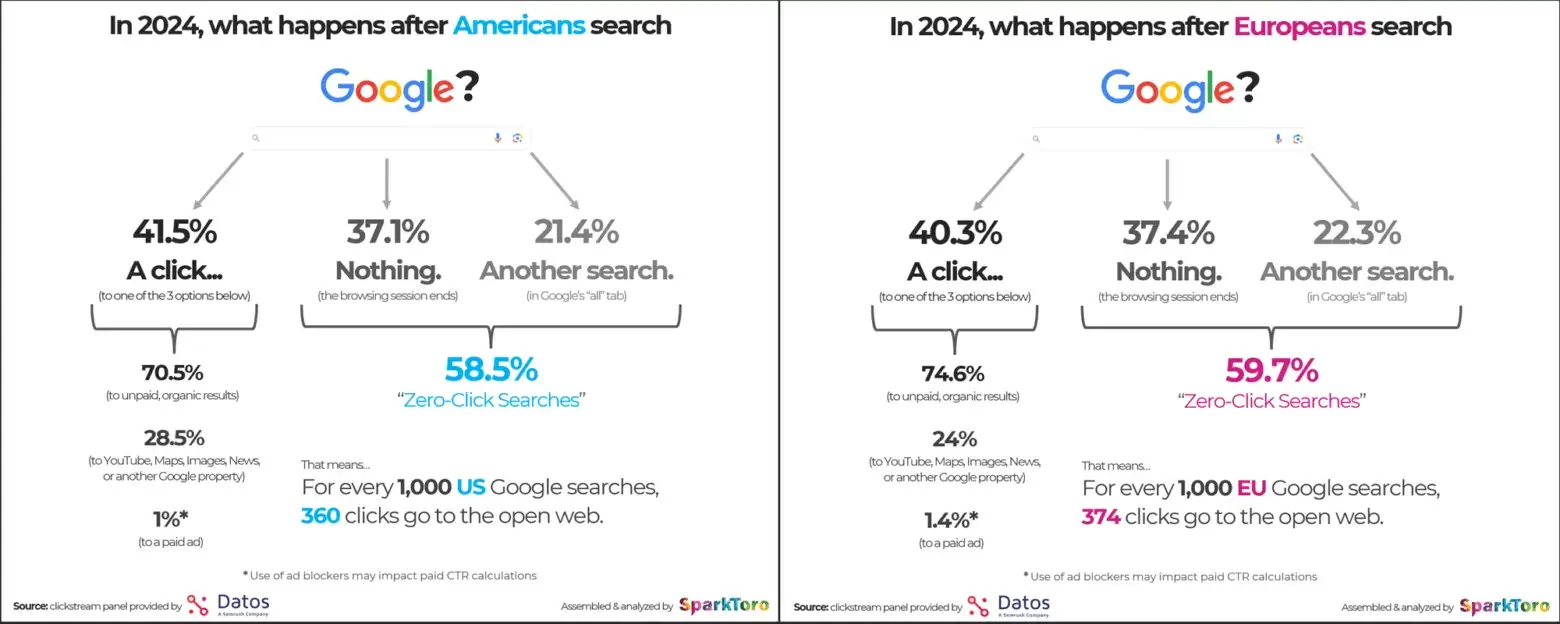
This trend shows people increasingly find what they need in featured snippets, knowledge panels, and AI summaries.
Users are now presented with, on average, six different Google features before even glimpsing the first organic results.
For top-value keywords, such as credit cards, users are even presented with 10 to 15 different Google features, making it super competitive.
These SERP features consist of:
- AI Overviews/Generated results.
- Knowledge panels
- People also ask
- Perspectives (Tweets, TikTok, YouTube videos)
- Top Stories (news) Also in the news
- Local packs and maps
- Google Hotels
- Image and video carousels
- Discussion and forums
- Featured Snippets
Another reason why:
Effective SEO is about expanding your digital footprint across the entire online ecosystem.
The United Brands Association projects this pattern will reduce website traffic by up to 25% by 2026 as search results pages become more comprehensive and self-contained.
Content Quality in an Age of Abundance
With AI tools making content creation faster and cheaper, we see “content ubiquity.”
Nevertheless, we can see automated content flooding the web and becoming the majority of online content within 1-2 years simply because it’s so easy to do.
This presents a difficulty for search engines, which aim to show people the most relevant and high-quality responses.
Not only is Google providing AI-generated summaries via AI overviews, but much of the content it crawls will also be AI-generated. In some ways, we may be heading towards a version of Dead Internet Theory.
While “Dead Internet Theory” is more of a metaphor than a proven claim, it highlights a real concern: the rapid rise of AI-generated content risks creating a content loop in which LLMs regurgitate their own outputs.
Google’s March 2024 update, which penalized 45% of low-quality content, directly responded to this.
This challenges agencies: while AI makes production easier, it increases the importance of human expertise and originality.
So while clients might want to push to go full “AI content only”, there needs to be a balance that brings in the unique insights and information that only the client’s expertise can bring to make their content stand out above the sea of sameness.
This balance is also shown by data from Semrush, which shows that 73% of marketers now combine AI-generated content with human oversight (Semrush Content Shake, 2024).
This balance can increase traffic through greater efficiency and scale.
Short-Term Impacts on SEO and SEA
SEO Adjustments
So if search is evolving beyond simple keywords to natural language patterns, companies need to optimize for how people communicate, using questions and conversational phrases.
SEO has gone through several distinct phases, and it is now entering a period in which AI-generated content presents new challenges and opportunities. Google’s AI overviews currently appear in about 30% of search results and nearly three-quarters of problem-solving queries. A study by Authoritas in January 2025 shows that AI Overviews are limited in overall presence on search engine results pages (SERPs) and are more common for mid-volume queries.
This indicates opportunities in areas with lower competition.
It also shows that specific industries are more affected than others. Moreover, about 33.3% of non-brand searches show an AI Overview, while only 19.6% of brand searches do. So, while AI Overviews might slow potential customers’ buying process, they can help influence how users view a brand during the early and mid-stages of decision-making.
This also shows the need for brand and awareness building, where SEA strategies can certainly help.
Effective content strategies now include:
- Content that directly answers specific questions
- Comprehensive topic coverage, also known as building “topical authority” rather than individual keyword targeting
- FAQ sections or question-based headings that mirror natural language
Structured data has transformed from optional to essential.
Example of schema markup.
As search engines increasingly rely on this technical foundation to generate AI overviews, proper implementation becomes critical, especially for product pages where AI can now compare offerings across websites.
Companies with complete schema markup gain significantly more visibility than those without it.
For blog content, technical optimization should include author information, reading time, modification dates, and executive summaries. Elements that help both users and search engines quickly understand the value proposition.
SEA Changes
The paid search landscape faces fundamental changes as results pages continue to evolve with AI integration.
AI now handles much of the operational work in paid search:
- Smart bidding systems optimize for maximum revenue
- Responsive Search Ads identify the most effective combinations
- Performance Max campaigns automate presence across platforms
This shift requires marketers to feed these systems with quality inputs:
- Diverse creative variations that test multiple approaches
- Localized content that resonates with specific audiences
- First-party data, including customer profiles and real-time product information
- Detailed audience segmentation based on website behavior and demographics
Zero-click searches reduce traffic, so SEA must build visibility and awareness earlier in the funnel.
Efficiency Gains
The new search landscape offers substantial productivity benefits when approached strategically.
Search fragmentation is creating both challenges and opportunities. While traditional search engines adopt AI features, entirely new AI-first search tools like Perplexity are gaining popularity with features like real-time information with cited sources and consolidated answers from multiple websites.
Companies can leverage this evolution through:
- Tracking visibility changes when AI results appear in their markets
- Monitoring shifting search behaviors through Search Console data
- Categorizing search terms to identify emerging trends
- Building dashboards to monitor market evolution continuously
This transformation requires marketers to become strategic leaders who set clear business KPIs to guide AI systems, rather than remaining tactical operators. Teams that embrace this shift can adapt more quickly while producing more effective content with fewer resources.
Long-Term Impacts on SEO and SEA
From Websites to Info Sources
Websites are becoming less central to search experiences. We’re now in “the age of Search fragmentation,” where tools pull answers directly from various sources.
This change means fewer clicks to websites. UBA data projects website traffic dropping by up to 25% by 2026 due to zero-click searches.
Organizations need to adapt by ensuring their content works effectively within tools like Google’s AI overviews and Perplexity. These systems already consolidate information from multiple sources, prioritizing visibility within these tools over traditional website visits.
New Ad Models
Traditional search ads are evolving quickly. Charlie Deschamps notes that “Search Ads will take many forms” in the future, moving beyond standard text formats.
New approaches include:
- Ads integrated within AI-generated answers
- Sponsored questions appear alongside organic results
- Advertising embedded in conversational formats
Perplexity’s upcoming advertising model shows where things are headed. Their approach includes integrating ads into “Related Follow-Up Questions” and creating publisher partnerships where content sources receive a percentage of ad revenue when featured in results.
This represents a significant change in paid search strategy, shifting focus from driving clicks to being present within answer systems.
Content Strategy Evolution
Content needs to be restructured to work in these new environments.
Content must:
- Work across modalities (text, visual, voice)
- Address longer, conversational prompts
- Be structured for modular reuse by AI systems
Ethical Considerations
New search approaches bring practical concerns about fairness and transparency. As information gets filtered through more systems, questions about bias and proper attribution become essential business considerations.
Content attribution is a key challenge. Perplexity’s revenue-sharing model with publishers offers one solution, but questions remain about how sources will be credited when content appears in conversational responses.
Data privacy takes on new dimensions as search patterns reveal more about user intent than traditional keywords. According to the UBA, marketers must maintain human oversight to “avoid biases and ensure alignment with the brand’s voice.”
These issues will likely lead to industry standards and regulations affecting how search systems operate, creating new compliance requirements for marketing teams.
Agency Evolution and Service Transformation
New Expertise Requirements
Marketing agencies face clear skill development needs as search transforms. We go from tactical operations to strategic guidance. Charlie Deschamps emphasizes that marketers must become “Strategic leaders and decision makers” who “The business KPI to guide AI” rather than implement tactics.
This means developing practical capabilities in:
- Working with AI-powered search tools effectively
- Creating structured data that feeds search systems properly
- Understanding how different platforms (from Google to TikTok to Perplexity) handle search
David Grunewald notes that companies like Pluginto.ai now offer “prompt engineering training” and “AI integration strategy” services, showing the market demand for these skills.
This highlights the growing importance of knowing how to effectively guide AI systems.
Content Strategy Shifts
Content production is changing fundamentally. The agency role now involves helping clients stand out in “the AI content flood.”
Traditional SEO approaches focused on keywords and basic optimization no longer deliver results.
Agencies must help clients:
- Create content that works across multiple search formats (text, voice, visual)
- Develop information that answers specific questions directly
- Build comprehensive topic coverage rather than keyword-focused pages
Native advertising will play an essential role in blending naturally into the user’s journey, requiring agencies to break down silos between organic and paid strategies.
AI Integration Services
Agencies can fill the growing need for practical AI implementation support. With services like “customized workshops” and “AI integration strategy and roadmap” development, agencies can position themselves in this space.
Key service opportunities include:
- Building structured data strategies for better visibility in AI systems
- Creating dashboards that track evolving search behavior
- Developing content that works effectively across fragmented search landscapes
And don’t forget the need for first-party data, as this will be crucial for optimizing campaigns,” presenting another area where agencies can provide value through data strategy and implementation.
Analytics Evolution
Another area where agencies can help and support clients is by updating their measurement approach. We shouldn’t just track traditional metrics; we should also measure visibility across LLMs and other platforms in the Search Everywhere Optimization approach.
Connecting Google Ads, Google Search Console, and other platform data to one centralized dataset like BigQuery for deeper analysis.
- Categorizing traffic types (brand, non-brand, product categories)
- Building visualization systems to track trends
- Combining click data with search volume to measure true visibility
By reframing success metrics, for example, “-5 % of traffic but -15 % of Search volume IS a positive outcome”, we can highlight these search behaviour changes to our clients.
Agencies must help clients understand that the quality of traffic matters more than quantity, as search fragments: “less website traffic” but “qualitative traffic” becomes the focus.
Key Takeaways and Action Plan
Search behavior is fragmenting as people increasingly treat search as a conversation rather than a keyword hunt.
AI tools like ChatGPT and Perplexity have brought in a new way of information retrieval, but Google still maintains a dominant market share.
Despite decreasing click-through rates, Google’s AI Overviews have not slowed its growth, but they have significantly reshaped how people interact with content.
Brands can no longer rely solely on top positions in traditional SERPs—they must now consider how their content performs within zero-click environments and AI summaries.
Content ubiquity, driven by generative AI, means that sheer volume is no longer a viable strategy.
Instead, content needs to be highly structured, informative, and visibly credible. Search engines are becoming more selective, with Google’s March 2024 core update slashing visibility for low-quality or redundant material.
This reinforces the need for unique, expert-driven content that earns trust and stands out in an oversaturated landscape.
Marketing agencies are also facing a transformation. No longer simply executors of SEO tactics, agencies must evolve into strategic consultants who help brands navigate fragmented search ecosystems.
This includes guidance on new KPIs, integrated analytics, and multi-platform visibility—not just search rankings.
Practical Next Steps for Brands & Agencies:
For Brands
Start by auditing your existing content, focusing on AI visibility and diversifying your content strategy. Understand which of your key search terms trigger AI Overviews and how your brand appears within them.
Reframe your SEO strategy to optimize not just for traditional rankings but also for inclusion in new SERP features by leveraging a diverse content strategy across platforms.
Work on inclusion in AI summaries by answering direct questions and using conversational, natural language.
A great place to start is by using the unique insights coming from the Sales, Support, and Customer Success teams. These teams are on the frontlines when it comes to talking with your customer so they know the exact questions they might have.
And finally, ensure you claim your digital real estate: own your brand’s Knowledge Panel, verify sitelinks, and build out any elements that appear in rich results. Strengthening branded search presence becomes critical as non-branded traffic erodes.
For Agencies
Agencies need to develop a GEO (Generative Engine Optimization) service line.
This starts by educating your team on how large language models choose what to cite and how structured content can boost inclusion.
Agencies need to conduct experiments in Perplexity and ChatGPT to see how their clients’ content performs in answer-based UIs.
Offer AI visibility dashboards using Search Console, Ads, and BigQuery data to provide clients with insights beyond clicks and rankings. Start tracking things such as featured snippet presence, AI Overview visibility, and brand mentions across AI tools.
Introduce ‘Prompt Strategy’ workshops to teach clients how to influence AI tools via well-structured content and clear brand narratives. This is especially relevant for industries that rely on expertise or trust-based decision-making, such as finance or healthcare.
Educate clients on evolving KPIs: shifting the conversation from raw traffic to qualified visibility and search presence across multiple platforms.
The role of Agencies is not only to execute, but to guide—showing how to thrive in a fractured, AI-powered search world.
Ready to turn this into action instead of another “interesting article”?
Book an SEO Power Hour with us, and we will look at how visible you really are in this new, AI-powered search landscape. In 60 minutes, we will pinpoint where you are losing clicks to AI Overviews and zero click results, where you can win back qualified traffic, and how to make your content show up more often in assistants like ChatGPT and Perplexity.
👉 Book your SEO Power Hour and see precisely how we can help your brand stay discoverable in a Search Everywhere world.



